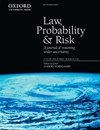后验似然比分布的认识论解释
IF 2.7
4区 社会学
Q1 LAW
引用次数: 3
摘要
似然比的表达式通常涉及模型参数θ。这一事实促使许多研究人员认为,似然比应该伴随着置信区间,就像估计θ本身一样。我们首先反对这一点,因为我们认为似然比是我们对模型参数知识的函数,而不是参数本身的函数。然而,还有另一个区间是可以构建的,并且已经在文献中介绍过了。这是从所谓的“后验似然比分布”中采样时获得的区间,例如,从该分布中去除样本的最极端5%。尽管这种结构出现在文献中,但其解释仍然不清楚,正如文献中明确承认的那样。在这篇文章中,我们提供了一种解释:后验似然比分布告诉我们,如果我们要获得更多信息,我们可以预期哪些似然比。因此,它可以在决策过程中发挥作用,例如关于是否值得尝试获取更多数据的问题。后验似然比分布与我们当前知识的当前数据的证据值无关。我们用一些例子来说明这一切。本文章由计算机程序翻译,如有差异,请以英文原文为准。
An epistemic interpretation of the posterior likelihood ratio distribution
Often the expression of a likelihood ratio involves model parameters θ. This fact prompted many researchers to argue that a likelihood ratio should be accompanied by a confidence interval, as one would do when estimating θ itself. We first argue against this, based on our view of the likelihood ratio as a function of our knowledge of the model parameters, rather than being a function of the parameters themselves. There is, however, another interval that can be constructed, and which has been introduced in the literature. This is the interval obtained upon sampling from the so-called ‘posterior likelihood ratio distribution’, after removing, say, the most extreme 5% of a sample from this distribution. Although this construction appears in the literature, its interpretation remained unclear, as explicitly acknowledged in the literature. In this article we provide an interpretation: the posterior likelihood ratio distribution tells us which likelihood ratios we can expect if we were to obtain more information. As such, it can play a role in decision making procedures, for instance about the question whether or not it is worthwhile to try to obtain more data. The posterior likelihood ratio distribution has no relevance for the evidential value of the current data with our current knowledge. We illustrate all this with a number of examples.
求助全文
通过发布文献求助,成功后即可免费获取论文全文。
去求助
来源期刊

Law Probability & Risk
MATHEMATICSSTATISTICS & PROBABILITY&-STATISTICS & PROBABILITY
CiteScore
2.10
自引率
28.60%
发文量
8
期刊介绍:
Law, Probability & Risk is a fully refereed journal which publishes papers dealing with topics on the interface of law and probabilistic reasoning. These are interpreted broadly to include aspects relevant to the interpretation of scientific evidence, the assessment of uncertainty and the assessment of risk. The readership includes academic lawyers, mathematicians, statisticians and social scientists with interests in quantitative reasoning.
The primary objective of the journal is to cover issues in law, which have a scientific element, with an emphasis on statistical and probabilistic issues and the assessment of risk.
Examples of topics which may be covered include communications law, computers and the law, environmental law, law and medicine, regulatory law for science and technology, identification problems (such as DNA but including other materials), sampling issues (drugs, computer pornography, fraud), offender profiling, credit scoring, risk assessment, the role of statistics and probability in drafting legislation, the assessment of competing theories of evidence (possibly with a view to forming an optimal combination of them). In addition, a whole new area is emerging in the application of computers to medicine and other safety-critical areas. New legislation is required to define the responsibility of computer experts who develop software for tackling these safety-critical problems.
 求助内容:
求助内容: 应助结果提醒方式:
应助结果提醒方式:


